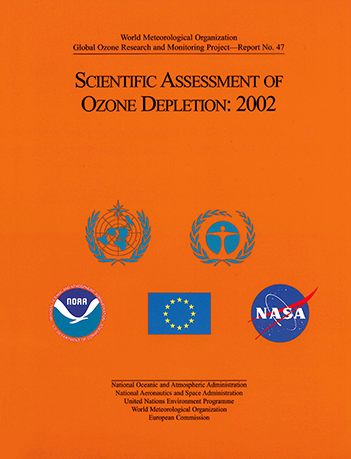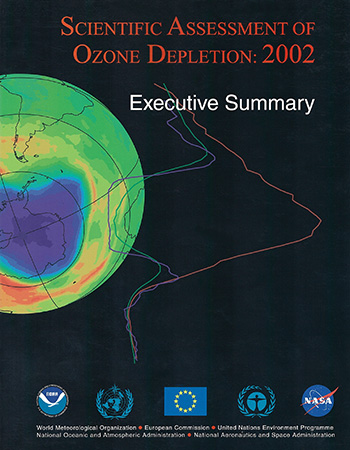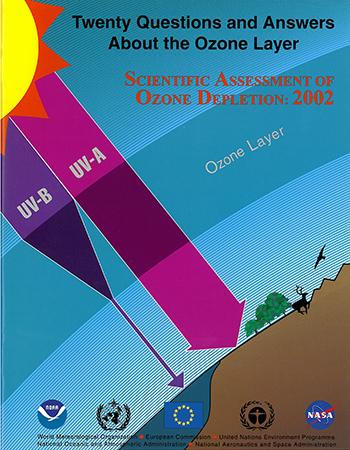Scientific Assessment of Ozone Depletion: 2002

The 2002 WMO/UNEP assessment, Scientific Assessment of Ozone Depletion: 2002, contains the most up-to-date understanding of ozone depletion at the time and reflects the thinking of 275 international scientific experts who contributed to its preparation and review. Co-chairs of this Ozone Assessment were Dr. Daniel L. Albritton of the NOAA Aeronomy Laboratory, Dr. Ayité-Lô Nohende Ajavon of the Université de Lomé, Dr. Gérard Mégie of the Centre National de la Recherche Scientifique, and Dr. Robert T. Watson of the World Bank. Other members of the Aeronomy Laboratory made substantial contributions to the report, serving as lead authors, co-authors, contributors, reviewers, coordinating editor, and editorial and computing support staff.
This Ozone Assessment consists of the Executive Summary, five detailed chapters and Twenty Questions and Answers About the Ozone Layer, listed with the names of the Lead Authors:
Chapter 1. Controlled Substances and Other Source Gases - Stephen A. Montzka and Paul J. Fraser
Chapter 2. Very Short-Lived Halogen and Sulfur Substances - Malcolm K.W. Ko and Gilles Poulet
Chapter 3. Polar Stratospheric Ozone: Past and Future - Paul A. Newman and John A. Pyle
Chapter 4. Global Ozone: Past and Future - Martyn P. Chipperfield and William J. Randel
Chapter 5. Surface Ultraviolet Radiation: Past and Future - James B. Kerr and Gunther Seckmeyer
Twenty Questions and Answers About the Ozone Layer - David W. Fahey

Executive Summary
The Executive Summary gives a synopsis of major scientific findings of the five chapters of the full report:
- Preface
- Recent Major Findings and Current Scientific Understanding
- Additional Scientific Evidence and Related Information
- Implications for Policy Formulation

Twenty Questions and Answers About the Ozone Layer
In the 2002 Ozone Assessment, the international scientific community included this section to answer several of the general questions that are most frequently asked by students, the general public, and leaders in industry and government. A draft of this component was reviewed and discussed by the 74 scientists who attended the Panel Review Meeting for the 2002 report in June 2002. In addition, subsequent contributions, reviews, or comments were made by individuals listed on the inside cover .
Individual components, including each question and associated figures:
- OZONE IN OUR ATMOSPHERE
- What is ozone and where is it in the atmosphere?
- How is ozone formed in the atmosphere?
- Why do we care about atmospheric ozone?
- Is total ozone uniform over the globe?
- How is ozone measured in the atmosphere?
- THE OZONE DEPLETION PROCESS
- What are the principal steps in stratospheric ozone depletion caused by human activities?
- What emissions from human activities lead to ozone depletion?
- What are the reactive halogen gases that destroy stratospheric ozone?
- What are the chlorine and bromine reactions that destroy stratospheric ozone?
- Why has an "ozone hole" appeared over Antarctica when ozone-depleting gases are present throughout the stratosphere?
- STRATOSPHERIC OZONE DEPLETION
- How severe is the depletion of the Antarctic ozone layer?
- Is there depletion of the Arctic ozone layer?
- How large is the depletion of the global ozone layer?
- Do changes in the Sun and volcanic eruptions affect the ozone layer?
- CONTROLLING OZONE-DEPLETING GASES
- Are there regulations on the production of ozone-depleting gases?
- Has the Montreal Protocol been successful in reducing ozone-depleting gases in the atmosphere?
- IMPLICATIONS OF OZONE DEPLETION
- Does depletion of the ozone layer increase ground-level ultraviolet radiation?
- Is depletion of the ozone layer the principal cause of climate change?
- STRATOSPHERIC OZONE IN THE FUTURE
- How will recovery of the ozone layer be detected?
- When is the ozone layer expected to recover?
- Understanding Stratospheric Ozone Depletion
- Heavier-Than-Air CFCs
- Global Ozone Dobson Network
- The Discovery of the Antarctic Ozone Hole
- Replacing the Loss of "Good" Ozone in the Stratosphere